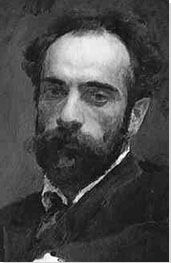Summary of Isaac Levitan
Isaac Levitan created some of the most beautiful works associated with the Peredvizhniki School and is credited, along with Ivan Shishkin, with ushering in a golden age of Russian landscape painting. Born poor in modern day Lithuania, Levitan moved as a child to Moscow. Orphaned and made homeless shortly afterwards, the young artist channeled the tragedies of his upbringing into creativity. He found success early, exhibiting with the Peredvizhniki Group as a student affiliate while still a teenager, and was swept up in the aims of that movement: to create a distinctly Russian art that would depict the beauty of the national landscape and the strength of the national character, withdrawing from European and Neoclassical models of aesthetic value. His own distinct contribution to this phase of Russian art was what we might call the "mood landscape": one represented with naturalistic accuracy yet imbued with a profound emotional and spiritual charge. Levitan's death in 1900 at the age of 39 deprived Russian and international art of a prodigious talent.
Accomplishments
- Isaac Levitan was amongst a generation of Russian landscape painters who sought to capture the unique beauty of the Russian wilderness, influenced by the Realist and Naturalist painters of France but determined to find their own, native muse. If Shishkin was the great painter of Russian forests, Levitan was a master of vast, open spaces, from the plains of Crimea to the banks of the Volga. His range was wide, however, and he also created more enclosed, human-centered landscapes.
- Like many artists of the Peredvizhniki School, Levitan's work was compelled by a strong, unorthodox spirituality. Whereas works such as Ivan Kramskoi's Christ in the Desert (1872) and Nikolai Ge's What is Truth? (1890) channeled some such sentiment into representations of Christ, the Jewish Levitan expressed a more esoteric, pantheistic faith, a sense of God-in-nature, through works of sublime scale and beauty such as Above the Eternal Peace (1894).
- Levitan learned from the achievements of the first generation of Peredvizhniki artists and created a distinct body of work in response, helping to bring about the second great wave of creativity associated with the school during the 1880s-90s. In his last works, we can sense a more explicit incorporation of the lessons of European Impressionism and Post-Impressionism, as color planes become more simplistic and exaggerated. But he remained, throughout, true to the nationalist animus of the Peredvizhniki School.
Important Art by Isaac Levitan
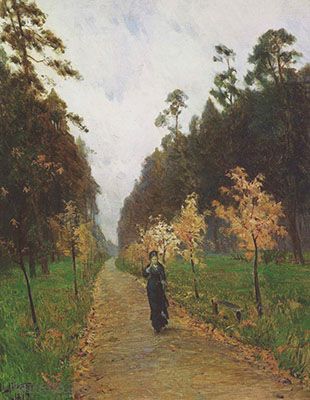
Autumn Day, Sokolniki
This work, painted when Levitan was 19, was the first acquired by the patron Tretyakov. It relies on a simple but effective compositional arrangement, with the two convergent lines formed by the edges of the path meeting those of the tree-line in the center of the canvas. The two reflecting triangles accentuate the depth of the composition and suggest the loneliness of the scene. The colors, though muted, are warm, and divided into a subtle spectrum: first, the bright hues of the grass and the path, then the golden yellow of the small and younger trees, behind them the higher trees, with their brown-green leaves, and finally, the blue of the sky.
In the foreground, the lady in black captures the eye. In a sense she is the subject of the painting, yet Levitan only added her later on, on the suggestion of his friend Nikolai Chekhov, who could not conceive of a work without human figures. Throughout the preparatory process of plein air sketching, Levitan focused on only the landscape, completing a number of drafts before finishing the canvas in the studio. In this sense, the landscape itself is the subject of the work. The viewer is struck first by the naturalism of the scene, still revolutionary at the time, and by the scale of the trees stretching upwards to the sky. The subtle formal arrangement might also seem to symbolize the passage of time, with the eye drawn upwards from the younger trees to the higher, darker trees, touching the white eternity. A strong emotion of sorrow is conveyed through the desolation of the setting, which would have been enhanced by the empty bench had the woman not been added. Still doubtful and insecure in his talent, perhaps, Levitan conceded to his friend, adding a romantic detail and a more anecdotal touch to the work.
Sokolniki is a park outside of Moscow where Levitan had settled for a time with his sister, having been expelled from Moscow as a Jew following the failed assassination attempt of Tsar Alexander II by a Jewish revolutionary. Dejected and lonely, we can imagine Levitan's feelings as he walked among the trees making sketches for this painting. The work was exhibited at a Moscow School exhibition, where it is said to have angered Levitan's mentor Savrasov, who found the woman "unnecessary". Nevertheless, the collector Tretyakov purchased the work and started to follow Levitan's career.
Oil on canvas - Tretyakov Gallery, Moscow
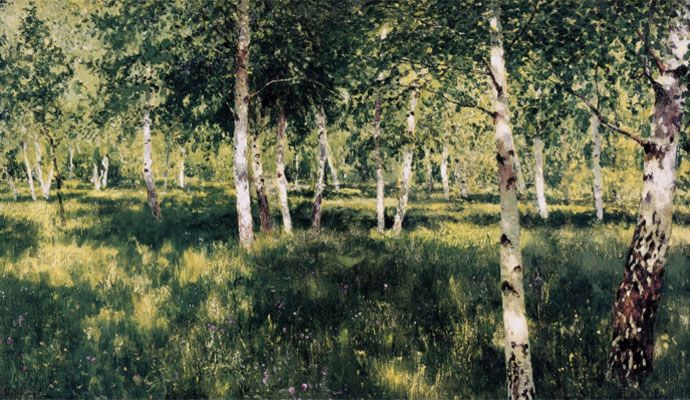
Birch Grove
This painting depicts a forest of birch trees on a sunny day. Small touches of bright yellow contrast with specks of dark green, heightening the luminosity of the canvas. The white of the trunks stands out, punctuating the landscape with vertical lines. Purple dots sprinkle the grass. Opting for an eye-level perspective, Levitan only includes a portion of the forest canopy, cutting off the treetops and much of the foliage, while suggesting their presence by depicting the light passing through to mottle the meadow beneath. The human's eye view invites us into the painting, as if we were experiencing the sensory pleasures of the birch grove firsthand. It took Levitan about four years to finish this small canvas. But despite the years of thought and corrections poured into the final outcome, the painting radiates with freshness and a sense of immediacy.
We can sense the influence of Impressionist techniques on the work, in particular Levitan's admiration for Camille Corot. Like Corot, Levitan captured the delicate beauty of light passing through foliage using small, quivering brushstrokes and precise gradations of colors. But the subject-matter, while comparable to the sylvan scenes of the Barbizon School or Impressionist milieux, is subtly nationalistic. The birch tree is often taken as a symbol of the beauty of the Russian countryside, and the artist made a conscious choice in selecting it.
Levitan's birch grove captured nature in its brilliant, sensory and emotional appeal, and inspired future artists. Gustav Klimt may have had this work in mind when composing his early landscapes, which seem to share compositional traits and motifs with Levitan's work. The work is also significant in suggesting the youthful joy of the artist; Levitan started to work on it at a positive point in his career, before the tribulations of his final decade.
Oil on canvas - Tretyakov Gallery, Moscow
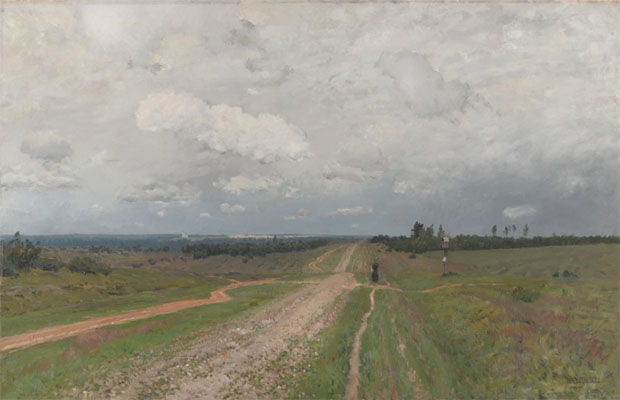
The Vladimir Road
This painting represents the Vladimirka or Vladimir Road leading east out of Moscow to the city of Vladimir. It was by chance that Levitan first discovered the road while out hunting with his mistress Sofia. Taken by the starkness of the scene, he decided to depict it. He painted it as he first saw it: empty and desolate, on a cloudy day. The composition is quite simple, with the horizon line dividing the canvas and crossing in its center the vertical line of the road. The latter is flanked by beaten footpaths on each side. The meandering of footprints is somewhat reflected in the light swirling movement of the clouds above, but this is a dreary landscape overall. The female character waiting in the middle distance recalls a sense of human presence, but underlines at the same time the vast stillness and loneliness of the place.
The subject was an emotive one for artists and free thinkers of Levitan's generation. The Vladimir Road was a historically charged location, used since the middle of the eighteenth century for transporting convicts from Moscow to Siberia, where they would be put to hard labor. In Russian artistic vocabulary, the road is associated with misery, imprisonment, and death. By choosing to depict it, Levitan immortalized the thousands of wretched outcasts who had marched along the Vladimir Road towards exile. He may have identified with them as someone who had himself been a beggar, forced to live on the fringes of society, and also as a man discriminated against and twice banned from Moscow for being Jewish.
Through the emptiness of the scene, and through the road that seems to open out to infinity, the artist conveys a strong feeling of despair which is at the same time an expression of compassion. Despite tapping into these elemental human emotions, the work is unusual in its rootedness in historical reference. Perhaps for this reason, Levitan ended up losing interest in it, and gave it for free to Tretyakov.
Oil on canvas - Tretyakov Gallery, Moscow
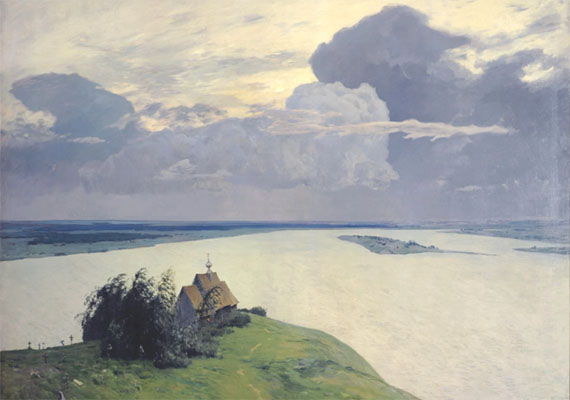
Above the Eternal Peace
This work is one of Levitan's most famous. It shows from a bird's eye view a church on a hill, overlooking the bank of a vast lake. There is a graveyard next to the church and a small island in the middle of the water. The lake is immense, still and peaceful, evenly painted in bright white, contrasting with the fresh green of the grass on the hill. The horizon line divides the canvas into two equal spaces, separating the air above from the land and the water below, but it is the huge sky that dominates. It is rendered in three different colors: a yellow-white for the dying light of the sun, purplish for the clouds that hint at the encroaching evening, and darker colors suggesting an approaching storm. It is a mighty, beautiful, imposing sky.
Although the landscape depicted is that of Crimea, the church on the hill is from Plyos, in the Volga region. Levitan had sketched it previously and reproduced it here to enhance the mood of the work. In a letter to Chekhov from Crimea in 1886, Levitan wrote: "Last evening I climbed up a cliff and looked down at the sea from the top - I started to sob, and sobbed violently; that was eternal beauty, that was where a human being felt his own utter insignificance!" This statement suggests something of the transportive quality of the painting itself. Elevated above a comfortable viewing position, we face nature and the elements alone. The sky is, in the truest sense, sublime, almost threatening in its immensity, yet simultaneously soothing in its beauty, filling the viewer with an overwhelming wave of emotion. One is led to contemplate the power of nature and what may lie beyond it. The graveyard on earth symbolizes the impermanence of life and the powerlessness of human beings set against the immutable force of nature. We might note that the sky is not reflected in the water, as if to suggest the imperviousness of the heavens to the scene below.
While working on this painting, the artist would often ask his lover Sofia Petrovna to play the piano, especially a "March Funebre" from Beethoven's Heroic Symphony, upon which tears would come to his eyes. Levitan, not a Realist painter, permeated this work with his emotion, imbuing it with highly philosophical and lyrical qualities. Writing to Tretyakov, who purchased it, Levitan declared: "I am all in it, with all my mind". Some historians have also seen in this painting a nationalist paean to the beauty of the Russian wilderness.
Oil on canvas - Tretyakov Gallery, Moscow
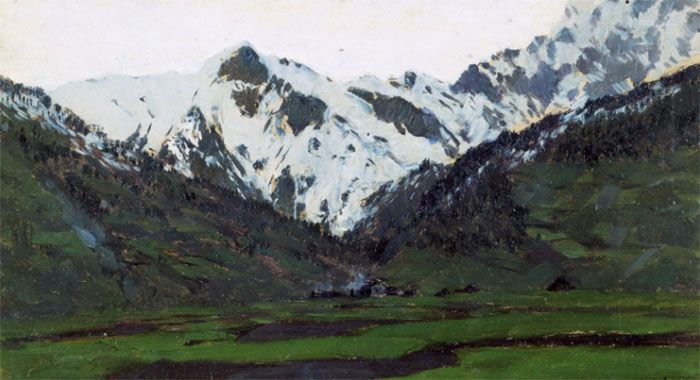
In the Alps in the Spring
This painting is one of the few works which Levitan dedicated to European landscapes across his career. Created while he was undergoing medical treatment in Courmayeur, a resort in Italy, the scene depicted is divided into three areas of terrain: the mountains in the background, the green valleys in the middle, and the flat plains in the foreground. A different color predominates in each section: bright white for the snowy peaks, dark green for the trees and grass on the slopes, and lighter green for the grass. In the very center of the canvas, at the bottom of the valley, a small hamlet stands out against the immensity, a cloud of smoke rising from it.
This painting translates the depth of emotion felt by Levitan when he saw the Alps for the first time: "Here I am at the foot of Mont Blanc and my heart is throbbing with admiration! It is so high, so far and so beautiful! Climb the top of Mont Blanc and touch the sky!" The artist was truly astounded by the scale and magnificence of the mountains, and something of this comes across through their placement high up on the canvas, leaving only a small segment of sky, as if the mountains had conquered it. The tiny size of the human settlement below enhances the sense of wonder conveyed by the vast peaks beyond.
If the mountains seem threatening in their awesome size, the fresh green of the valleys in the foreground, and the presence of the hamlet, makes this a less austere scene, and suggests an interest in human life and renewal. This is spring, after all, season of renewal, and water is melting from the peaks into the land, running in rivers across the plain. Given that Levitan was in Courmayeur for treatment of the heart condition that would eventually kill him, the spirit of hope and affirmation conveyed by this work is especially poignant.
Oil on canvas - Private Collection
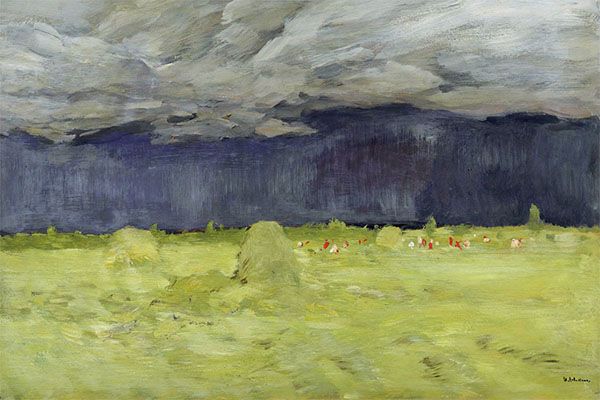
Haystacking
This is one of Levitan's last works, executed in the year of his death. The formal qualities of the painting are striking, suggesting a late, experimental turn in his style. The canvas, a rectangle of cardboard, is divided into three bands of color: green, blue and grey. The darker green verticals and red dots towards the top of the green stripe impose themselves clearly enough to relay the presence of a landscape, but not clearly enough to override the strong sense of abstract, formal arrangement.
In the last part of his career, Levitan created several works depicting haystacks. This one seems to be the final expression of the effect he was trying to achieve. With works such as Haystacking, Levitan reached an extreme stylization and simplification of form and color. His last paintings indicate his knowledge of and debt to the Impressionists, especially Monet. Indeed, the motif of the haystack clearly recalls the older French painter. However, the Russian remained truthful to his emotionally invested approach to landscape painting, and was not interested in the scientific side of Impressionist lighting. The result is a strange and solemn work, with a mood and formal appeal all of its own, almost suggesting the bold and distinct color plains of Post-Impressionist movements such as Synthetism.
Despite its radical formal simplicity, this is a striking and well-balanced work. The layout of the colors and their modulation create a great sense of depth; and there is no deletion of the landscape, no absence of subject. It gives a tantalizing hint as to how Levitan's work might have developed had his career not been cut short by his early death in 1900.
Oil on cardboard - Tretyakov Gallery, Moscow
Biography of Isaac Levitan
Childhood
Isaac Levitan was born on August 30, 1860 in the small town of Kibarty, now part of Lithuania but then incorporated into Congress Poland, a province of the Russian Empire. His family were Jewish. His father Ilya Abramovich, the son of a rabbi and an educated man, worked as a private French and German tutor and later as a translator for a French construction company. But the family was poor. Isaac's mother, a housewife, struggled to care for Isaac, his brother Abel, and his sisters Teresa and Emma. Nonetheless, both parents encouraged their two sons' early interest in art, and young Isaac would often escape the stresses of the family home to draw the trees and grass around the city.
Early Training and Work
In hopes of a better life the Levitan family moved to Moscow in the early 1870s. Living conditions were extremely poor, and they got used to living hand to mouth. However, the parents allowed their sons to follow their art careers. In 1873, at the age of thirteen, Isaac enrolled at the Moscow School of Painting, Sculpture and Architecture - also called the "Art School" or the "Moscow School" - following in his brother's footsteps. The Moscow School was more modern and progressive than the Neoclassically-inclined St. Petersburg Academy. Indeed, Moscow was then at the center of a progressive movement in painting that rejected the European academic standards promoted by Russian state culture. At the School, Levitan was immediately noted for his talent. To reward him for his achievements during the academic year 1874-75, and in acknowledgement of his financial predicament, the School Board awarded him a box of paints and brushes.
In 1875, Levitan's mother died, followed in 1877 by his father. Living conditions worsened for the orphaned children. While the sisters rapidly married, and Levitan's brothers were able to find basic housing, Isaac became homeless, living almost as a beggar. Constantly hungry, he would sleep in the homes of relatives or friends, or even in the empty classrooms of the Moscow School. Starting in 1877, the School waived his tuition fees, partly "because of extreme poverty" but also in recognition of his "singular success in art". They also offered him a small stipend to purchase canvas and paints. M.V. Nesterov, a contemporary of Levitan's and fellow student at the Moscow School, recalled in his memoirs that Levitan was as well-known amongst his peers for his poverty as for his talent.
Levitan quickly showed a preference for landscape painting and soon joined the studio class of the famous landscape painter Alexei Savrasov, then considered the most advanced in the Moscow School. The enthusiastic, bold and noisy teacher encouraged his students to work outside and to study nature at first hand. He often held outdoor sessions, in the morning light of early spring. For Savrasov, the value of a painting lay not in its "photographic resemblance" but in the strength of emotion it conveyed. Levitan, like most of Savrasov's students, loved his master and was greatly influenced by him. Savrasov, for his part, favored Levitan and took a special interest in his development. Levitan discovered with Savrasov the work of Jean-Baptiste-Camille Corot, whom he grew to love. It is said that the young Isaac taught himself French in order to read a book on Corot by Theophile Silvestre published in 1853. In spite of these creative discoveries, Isaac was remembered by his fellow students - with whom he sometimes painted on the outskirts of Moscow - as a sad young man, who had suffered too early the sorrows of orphanage and destitution.
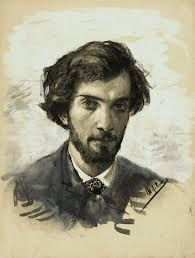
Levitan was only sixteen when his name appeared in the press for the first time. In March 1877, two of his paintings were exhibited in the student section of the fifth show of the Peredvizhniki (the Wanderers, or the Society of Traveling Exhibitions). They were very well received: Levitan was awarded with two minor silver medals and he started to receive public recognition for his work.
In April 1879, Alexander Soloviev, a Russian Jew, attempted to assassinate Tsar Alexander II. The Empire imposed a rigorous system of censorship and repression in Russia, including stronger anti-Semitism orders. Jews were banned from big cities, and Levitan was forced to leave Moscow in May 1879. Taking refuge on the outskirts of the city at his sister's home, Levitan continued to work restlessly. Every morning, he would wander in Sokolniki Park, making sketches and studies for his painting Autumn Day, Sokolniki. A year later, Levitan was allowed to return to the Moscow School after pressure from teachers and classmates who urged officials to allow him back.
In 1880, at the second exhibition of the Moscow School, Levitan exhibited five landscapes. Pavel Tretyakov, a famous art collector known for supporting young artists including those of the Peredvizhniki, purchased Autumn Day, Sokolniki and started to follow Levitan's career carefully. The show was a great success for Levitan, who was still only twenty; he continued to participate regularly in exhibitions held by the School, as well as shows staged by the Moscow Society of Art Lovers. In 1881, Levitan received a silver medal for a model's drawing and a stipend to travel to the Volga region, one of his dreams. This region was very important for artists of the time, symbolizing the unique beauty, culture, and identity of the Russian nation. Unfortunately Isaac's sister Teresa fell ill and he was forced to spend the funds he had been given on doc¬tors' bills, postponing his trip. To supplement his income, Levitan gave private art lessons, and worked as a graphic artist and lithographer for the magazines Moskva ("Moscow"), Raduga ("Rainbow") and Volna ("Wave") magazines from 1882 to 1884.
In 1882, Levitan started to study under Vasily Polenov, a famous landscape painter associated with the Peredvizhniki movement. Polenov introduced him to the art of the Impressionists and Barbizon School, and of Western Europe more generally. During his studies under Polenov, Levitan befriended Konstantin Korovin, later considered an Impressionist, and Nikolai Chekhov, the brother of Anton Chekhov, who would become one of his closest friends. The same year that Levitan began lessons with Polenov the School was forced to dismiss his former teacher Savrasov, who had succumbed to alcoholism and was more and more often arriving late and drunk, or failing to attend the School at all. Levitan, however, continued to seek Savrasov's advice, and the two remained close until the master's death in 1897. In 1883, Levitan went to show Savrasov a painting he hoped to enter into a competition. Savrasov wrote "Big Silver Medal" on the back of the canvas and signed it. It is believed that when the School committee saw the comment of the disgraced teacher they rejected Levitan's entry. Sad and disappointed, Levitan stopped attending classes. A year later, the School committee refused to reward him a First Rank Artist grade, instead giving him a diploma of "unranked artist", only qualifying him to work as an art teacher. Levitan left the School under a cloud.
Mature Period
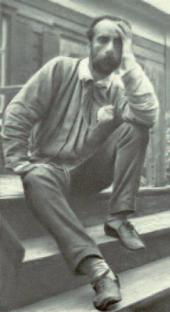
In spite of his fractious departure from the Moscow School, Levitan's career was blossoming. In early 1884, at a general meeting of the Peredvizhniki, he was accepted as a contributing member. Levitan featured as a full Peredvizhniki member for the first time in the Society's twelfth exhibition, and became known as one of the most talented of the second generation of the Wanderers, exhibiting every year with them from then on. His circle of creative compatriots at this time included Polenov, his former teacher and Levitan became a regular at Polenov's country house outside of Moscow, attending his morning watercolor sessions and evening drawing sessions. Levitan was often used as a sitter during these evening sessions, with other artists recalling his "beautiful head". Mikhail Nesterov, for example, described Levitan as "beautiful with a serious Oriental beauty", while another of his contemporaries wrote in a letter: "[y]ou had to look into his eyes. I believe I have never seen eyes so deep, dark and pensively sad." Polenov introduced Levitan and his friend Korovin to the important patron Savva Mamontov. Levitan was soon invited to evenings at Mamontov's famous house, where the industrialist had established something of a colony of progressive artists. Together with his friends Nikolai Chekhov and Viktor Simov, Levitan would create sets for Mamontov's private theater company.
During the summers Levitan, like many Russians, left the scorching city for the country. During the summer of 1885, he stayed in the village of Maksimovka, where the Chekhovs had a country house. Welcomed as a friend of Nikolai's, Levitan soon moved in with the family, and a close relationship with Anton Chekhov developed.
Over the course of his career, Levitan was very active in art circles and attended many events and gatherings at different artists' and patrons' residences in Moscow and across the country. In addition to Mamontov's evenings, he attended the Saturday soirées at the Moscow Society of Art Lovers, a meeting ground for older artists such as Polenov, Vladimir Makovsky, and Nikolai Nevrev. Levitan also frequented the famous Wednesday gatherings at the home of Vladimir Shmarovin, whose regulars included art critics, actors, and poets as well as artists. All these circles and groups were part of the early Russian avant-garde, that sought to promote a distinct Russian culture and identity in opposition to the Western cultural ideals instilled during the reign of Peter the Great. Levitan adhered closely to these ideas and remained determined throughout his career to depict the uniquely Russian beauty of his nation's landscapes.
Through the Chekhovs, Levitan met Sofia Petrovna Kuvshinikova, an amateur landscape artist married to a doctor. The two artists developed a friendship that soon grew into a romance lasting for many years. They would travel together, often with Sofia's husband, who tolerated the affair, and Levitan often asked Sofia to play the piano while he worked. It is said that the couple served as the inspiration for the main characters in The Grasshopper by Chekhov, published in 1892. Unfortunately, Isaac and Sofia were hurt by their perceived depiction in the story, leading to a rift between Chekhov and Levitan, who stopped talking to each other for some time, before reestablishing contact in 1895. Nonetheless, the correspondence between the two men reveals a very close relationship, based on mutual respect, shared emotions and ideas. Indeed, the art historian Galina Churak has posited that the artist and the author matured in parallel. Churak establishes many links between Levitan's landscape paintings and the tone and detail of Chekhov's writing.
By the mid-1880s Levitan's career was blooming, and he was able to travel quite widely. In 1886 he spent two months in the Crimea region, where he drew about 60 sketches, all of them sold at the Moscow Society of Art Lovers exhibition later in the year. Sketches were an important currency for Levitan, always retaining the traces of his first emotional responses to a scene. In 1887, he fulfilled his dream of traveling to the Volga region. He would return there almost every summer subsequently, accompanied by Sofia and visiting many cities on the river. He was especially fond of the town of Plyos, where he bought a home. During all of these trips, Levitan would work tirelessly, sketching and drawing en plein air. Indeed, he produced a huge number of works during his relatively short life. About 1000 paintings exist to this day, and as many or more drawings and sketches. Levitan was also a passionate hunter, who could reportedly spend days alone in the forest with his dog, often going without food. Once a friend even alerted the police to his absence because Levitan had been gone for so long.
Back in Moscow, Levitan would focus on his paintings and larger works. He would regularly exhibit with the Peredvizhniki group and with the Moscow Society of Art Lovers, his work always well received among artists and the public in general. In 1887, the artist Vasily Vereshchagin acquired Morning in Autumn, A Fog (1887) as a token of recognition of the young artist's professional maturity.
In 1890, Levitan traveled abroad for the first time. He visited the European cities of Berlin, Paris, Nice, Menton, Venice and Florence. He was impressed by little villages in Italy and stunned by the Alps. He kept a travel sketchbook and executed several "European" paintings. He would go again in 1894 and in 1897.
In September 1892, Jews were expelled from Moscow once more and Levitan was ordered to leave. It was only by virtue of his friends' and art collectors' pleading that he could move back home by the end of the year. An official per¬mission to return was issued to him in January 1894, thanks to the mediation of the artist Pavel Bryullov, a member of the Peredvizhniki Society Board. Levitan was 'accepted' back thanks mostly to his talent. He started to achieve international recognition at this time, with some of his paintings featuring in the World Fairs at Chicago (1892), London (1894), and Paris (1900). In 1896, he exhibited with the Munich Secession, a group loosely associated with Art Nouveau.
Late Period
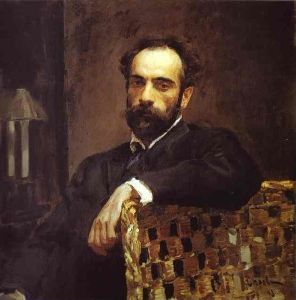
1895 was a year of tragedy for Levitan. He was diagnosed with a serious heart illness and was profoundly shocked. He attempted suicide twice, "as a consequence of aggravated neurasthenia" according to one of his biographers. After suffering a heart attack, he travelled abroad for medical treatment, notably spending time in an Alpine resort in Italy, where he was overwhelmed by the views of the mountains.
In 1898, he began to teach at his alma mater, the Moscow School, where he was appointed Head of the Landscape Studio, following the path of his mentors. His health condition was not getting better but he continued to work diligently, painting, sketching, drawing, and producing landscapes filled with peaceful light. He traveled and attended exhibitions, notably the opening of the 28th Peredvizhniki exhibition, where he wanted to see featured artworks by his students alongside his own. He was loved as a teacher, involving himself closely in the careers and fortunes of his pupils.
Until the end of his life, Levitan kept creating. His very late works show his awareness of new trends in international painting, and evidence of individual experiment. But his illness worsened. He died on July 22 of 1900 at the age of 39, and was buried in Moscow's Jewish cemetery. In 1941, his remains were transferred to the Novodevichy Ceremony, where he was buried next to the grave of his dear friend Anton Chekhov.
The Legacy of Isaac Levitan
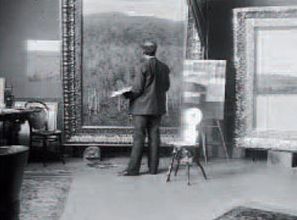
Levitan is considered one of the most important artists in recent Russian history, noted in particular for his contributions to the Russian landscape genre. Like his teacher and mentor Savrasov, he placed the Russian countryside at the heart of his work at a moment when the Empire was choosing between westernization and native cultural identity. This was a striking gesture in itself. But Levitan's love for his native land conveyed itself through images of such profound, emotional and poetic depth that his contribution to the Russian landscape tradition can be seen as truly exceptional. As a teacher at the Moscow School he influenced his students, setting a new trajectory in Russian landscape painting. As his biographer Federov-Davidov wrote, "we can say without exaggeration that after Levitan, Russian landscape painting entered a new stage and acquired quite a new character."
Levitan's influence in Russia also extends across media, including film. When depictions of nature became central to Russian cinema, famous directors such as Sergei Eisenstein turned to Levitan's visual language for inspiration. A recent exhibition in Moscow included sequences from many Russian films shot in locations depicted in Levitan's paintings, or recreating the same mood as particular works of his.
This is not to say that Levitan's legacy is purely nationalistic. His gift for conveying emotion and spirituality through landscape transforms his paintings into reflections on eternity, nature, and humankind with universal resonance, adding a philosophical and phenomenological dimension to their value. His relatively short career, his unique life-path, and his enormous productivity add an element of color to his legacy.
Influences and Connections

-
![Jean-Baptiste-Camille Corot]() Jean-Baptiste-Camille Corot
Jean-Baptiste-Camille Corot - Alexei Savrasov
- Vasily Polenov
- Konstantin Korovin
- Nikolai Chekhov
- Konstantin Korovin
- Nikolai Chekhov
 Ask The Art Story AI
Ask The Art Story AI